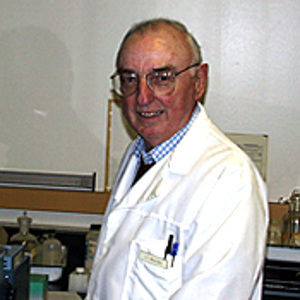
Emeritus Professor – Deceased
Ph.D., University of North Carolina, 1960
Research Interests
My research interests have as their central theme the understanding of how growth and development is regulated. A major achievement has been a series of studies that defined the fundamental aspects of the biology of the aquatic fungus Achlya. This broadly based program has included nutrition, physiology, biochemistry, enzymology, and ultrastructure. The University of Florida has the special distinction of having a broadly based scientific faculty and this has allowed us to exploit the best techniques and skilled people in addressing these fundamental questions. Most recently we have determined the molecular structure of a unique food reserve which occurs in a number of organisms, including Achlya. This molecule stores not only glucose, but also phosphate by utilizing the phosphodiester chemical linkage. This linkage allows a small neutral molecule to aggregate into a very large acidic one. This demonstrates that carbohydrates, as well as nucleic acids, have taken advantage of the unique chemical bonding of the phosphoric acid molecule. When appropriate we are also interested in the applied aspects of our research results. In this light we have contributed to a better understanding of the fundamental biological aspects of fuel ethanol production from Florida crops, and the microbiology of composting of yard wastes.
Representative Publications
- 1999. Du, Xin and J. T. Mullins. Glucan 1,3-ß-glucosidase activities of Achlya bisexualis: synthesis and properties. Mycologia 91: 353-358.
- 1998. Du, Xin and J. T. Mullins: Ca2+-induced sporulation in Achlya bisexualis: reserve (1->3)-ß-glucans provide both carbon and phosphorus. Mycologia 90: 990-994.
- 1997. Shapiro, A. and J. T. Mullins. Localization of cytoplasmic water-soluble reserve (1->3)-ß-glucans in Achlya with immunostaining. Mycologia 89: 89-91.
- 1996. Lee, J.-H., J. T. Mullins, and J. E. Gander. Water-soluble reserve polysaccharides from Achlya are (1->3)-ß-glucans. Mycologia 88: 264-270.
- 1994. Mol, P. C., H.-M. Park, J. T. Mullins and E. Cabib. A GTP-binding protein regulates the activity of (1->3)-ß-glucan synthase, an enzyme directly involved in yeast cell wall morphogenesis. J. Biol. Chem. 269: 31267-31274.
- 1994. Mullins, J. T. Hormonal control of sexual dimorphism. In: The Mycota. Vol. I. Growth, Differentiation and Sexuality. J. G. H. Wessels and F. Meinhardt (eds.) Pp. 413-421. Springer-Verlag, Berlin.
- 1994. Lee, J. H. and J. T. Mullins. Cytoplasmic water-soluble ß-glucans in Achlya: response to nutrient limitation. Mycologia 86: 235-241.
- 1991. Cabib, E., S. Silverman, A. Shaw, S. Das Gupta, H. E. Park, J. T. Mullins, P. Mol and B. Bowers. Carbohydrates as structural constituents of yeast cell wall and septum. Pure and Appl. Chem. 63: 483-489.
- 1990. Mullins, J. T. Regulatory mechanisms of ß-glucans synthases in baterica, fungi, and plants. Physiologia Plantarum 78: 309-314.
- 1988. Mullins, J. T. and C. C. NeSmith. Nitrogen levels and yeast viability during ethanol fermentation of grain Sorghum containing condensed tannins. Biomass 16: 77-87.